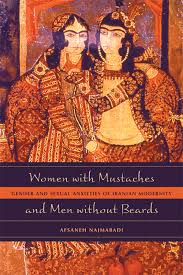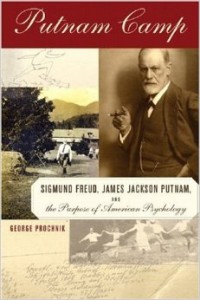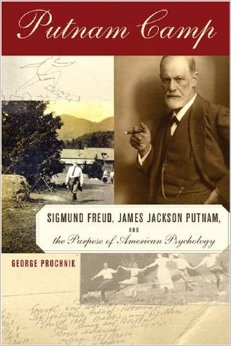 Women with Mustaches and Men without Beards:
Women with Mustaches and Men without Beards:
Gender and Sexual Anxieties of Iranian Modernity
by Afsaneh Najmabadi
Univ. of California Press. 363 pages, $24.95
This provocative piece of scholarship does not merely tell a history of the modern Middle East through the lenses of gender and sexuality; it also demonstrates how the shifting cultural definitions of gender and the changing normative meanings of sexual desire over the course of the 19th century were central to the making of Iranian modernity. Najmabadi begins by showing that in early Qajar Iran (1785–1925) standards of beauty were not gender-specific: male youths (“amrads”) as well as women were both deemed beautiful and sexually desirable by adult men, who were distinguished from the amrads by the marker of a full beard. By the end of the 19th century, however, love and erotic attraction became heterosexualized: beauty was now associated only with female femininity, while acceptable notions of male beauty and male same-sex love gradually disappeared. Analyzing both visual and textual sources carefully without compromising historical accuracy, Najmabadi reconstructs a gender-sensitive story about the lion-and-sun national emblem, rereads the significance of women’s veiling, and cautiously explores the intricate connections between women’s educational reform, the emerging institution of romantic marriage, and contested notions of womanhood in relation to Iranian nation-state formation. According to Najmabadi’s post-colonialist critique, the modernist effort to erase the amrad, the male object of desire, from the recent Iranian past in part could be attributed to the increasingly intensified interactions between Iranian and European men in the 19th century. Although to some this may be the weakest part of Najmabadi’s overall argument, the book’s most valuable gift lies in its refusal to separate gender and sexuality as two distinct analytic categories, a brave and exceptional method that should be emulated by historians to come.
Howard Hsueh-Hao Chiang
 Independent Queer Cinema: Reviews and Interviews
Independent Queer Cinema: Reviews and Interviews
by Gary M. Kramer
Southern Tier Editions (Haworth).
225 pages, $16.95 (paper)
This snappy, readable overview of recent queer movies, broadly defined, is divided into short articles or chapters within two sections: interviews and reviews. If you want to gain a nodding acquaintance with a variety of movies made since the early 1980’s with GLBT themes, this book can be a handy resource; but if you want to acquire an in-depth knowledge of the topic, it is likely to disappoint. Although Kramer’s stated goal is to rescue underrated films from obscurity, several of those he reviews are Hollywood productions which have had mainstream distribution. These include the biopics Kinsey (about the groundbreaking sex researcher of the 1950’s), De-Lovely (about the bisexual composer Cole Porter), and Monster (starring Charlize Theron in a brilliant performance as Aileen Wuornos, “the Florida prostitute who tried to turn her life around when she fell in love with a woman,” although she never identified as “lesbian”). Kramer also tackles real-life material of which he claims to have no personal knowledge, including the gay-male “circuit party” scene. Circuit, written and directed by Dirk Shafer, aims to show the seductiveness of the scene, while Party Monster (1998 and 2003) tackles the case of a popular party host of the 1980’s who was convicted of killing another man while “addled by drugs.” (The earlier film is a documentary by Randy Barbato and Fenton Bailey, and the later one their dramatized version of this incident.) This book contains a wealth of material that would be hard to find in any other single place, and the author’s shameless subjectivity is part of its charm. Readers who want to form their own opinions of the films under discussion are given enough information to find them.
Jean Roberta
 Putnam Camp: Sigmund Freud, James Jackson
Putnam Camp: Sigmund Freud, James Jackson
Putnam, and the Purpose of American Psychology
by George Prochnik
Other Press. 480 pages, $29.95
I cannot overstate how important I believe this book to be. It is a book about a short stay Freud had in the United States in 1909, during which his great discoveries were watered down for the American market and he was abandoned by colleagues that he found he could not trust, particularly Jung, who appears as a very unpleasant and nasty person. But the revolutionary material Prochnik has uncovered—stuff I have never seen, read, or heard about—is that Freud had no trouble with homosexuality (this is more than just being “accepting” of it), and that he did not mind fantasies that he knew to be homoerotic, and that he himself had such fantasies, including on this particular trip with Jung himself. All these years Freud’s words have been twisted by his “followers” into a hate for homosexuals that he himself never harbored. Thus this book is, for this gay reader, one of the seminal new bits of this endless puzzle of why we have been hated, a question this quiet and beautifully written book by a heterosexual Harvard scholar may help to put right at last. Prochnik writes about much more that happened on this trip; his cast of characters also includes William James, Emerson, Ferenczi, Adler, Brill, Jones, all the biggies of that day. And he makes you care about them. Freud himself is made infinitely moving and sad in a way that I have never encountered. By the end of this history, Freud is all alone, without the friends who once supported him and sat at his feet, his great system of treatment butchered by alien philosophies of treatment that had nothing to do with what he had said. I couldn’t put this book down, but after doing so it took me three days and evenings to absorb it.
Larry Kramer






